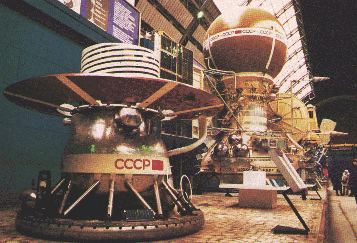|
|
Venera 11 & Venera 12

Credit: Sky & Telescope |
Venera 11 was launched on 9 September 1978. It, and
its sister, Venera 12, which was launched on 14 September 1978, traveled to
Venus with a separation of ~0.02 AU. Later, the separation increased to 0.5
AU. The Venera spacecraft could either be spin stabilized with a spin period
of several hours, or 3 axis stabilized. In general, the satellite was spin\
stabilized before encountering Venus, and 3 axis stabilized thereafter. The
Venera 11 mission was terminated in February 1980. The Venera 12 mission ended
in April 1980.
There were 2 separate instruments aboard the Venera 11 & 12 satellites:
the SIGNE 2 experiment and the KONUS experiment.
Veneras 11 and 12 were part of the French-Soviet collaboration SIGNE 2. The
SIGNE 2 project consisted of French-built gamma ray detectors on the Soviet
satellites Venera 11, Venera 12, and Prognoz 7. These 3 satellites then formed
an interplanetary gamma-ray burst triangulation network. Two features made
this program unique in its time: it was the first time that identical
detectors had been used simultaneously for gamma-ray burst studies on separate
spacecraft over interplanetary distances, and the experiments used the largest
dedicated gamma-ray burst detectors put into orbit.
Both Veneras had two dedicated gamma-ray burst detectors, arranged in such a
way that they viewed 4-pi steradians. Each detector consisted of a 4.5 X 3.7
cm NaI(Tl) crystal surrounded by an 8mm thick plastic anticoincidence jacket.
The crystal and plastic were viewed from the side by photomultiplier tubes.
The gamma-ray burst detector operated in low time resolution
"waiting" modes in the absence of a burst; low energy resolution
spectra and higher energy resolution calibration spectra were transmitted in
this mode. Typically, the data were accumulated into 120.0 s time bins, 1-31
energy channels. Detection of a burst triggered the storage of high time
resolution count rates and spectral data. The trigger criterion was an excess
count rate 8 sigma above normal in a 250 ms interval. The maximum time
resolution was 1/512 s. The energy ranges examined for burst detection ranged
from 50-270 keV to 600-3000 keV, depending on the detector mode. During a
burst, there were 1-6 energy channels used, and, for a "typical"
burst seen with Venera 11 & 12, the nominal energy range was 80-800 keV.
The readout time was ~4 s. However, two successive bursts could only be
detected if the interval between them was 3-20 minutes. In addition, the
storage of information on-board the spacecraft limited the number of
distinguishable bursts to 1 every 2 hours.
Also aboard the 2 spacecraft was the KONUS experiment. It consisted of 6
scintillation detectors, a set of 6 devices for gamma-ray burst detection
against the current background, 6 counters to measure the count rate in each
sensor, a 320-channel time analyzer, and a 128 channel PHA. Each scintillator
was a NaI(Tl) crystal with 80 mm diameter and 30 mm thickness. The background
was measured over the energy range 50-150 keV for count rate, and over the
range 30 keV - 2 MeV for spectra. Eight seconds of preburst data was recorded
when a trigger was issued, with a resolution of 0.25 s. The temporal profile
of the burst was recorded in 3 ways: 2 s with 15.625 ms resolution, 32 s with
0.25 s resolution, and an additional 32 s with 1 s resolution. The PHA trigger
mode was a 16 channel, quasi-logarithmic energy scale mode which measured 8
energy spectra in 8 successive intervals of 4 s each. The threshold sensitivity
at the 6-sigma trigger level was ~4 X 10-7 erg/cm2.
A catalog of the Konus experiment results was published in a series of
papers by Mazets et al. in 1981. Other results can be found in Mazets and
Golenetskii (1981), where 85 bursts were discussed. Based on their logN-logS
plots, they believed that bursts must be of galactic origin. The data showed
that the total energy released by a typical gamma burst event was 1040-1041 ergs.
[Gallery]
[Publications]
|
